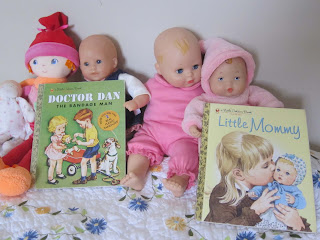Our newly-minted two-year-old younger lass has long loved baby dolls of all sizes and types. Presently she favors teensy tiny (or "tinsy", as the elder lad used to say) "vintage" Strawberry Shortcake figurines and other diminutive babies, but the doll my great aunt made for me holds pride of place in the girls' room as well as in their arms.
When we read Rebecca Caudill's The Best Loved Doll, all three of us females in the family were smitten. In spite of its considerable length for a picture book, the sweet story held the attention of the three-year-old elder lass as well as her not-so-baby sister. The girl in the story is invited to a party one afternoon with instructions to bring her favorite doll. Prizes will be given to dolls in three categories, any of which the girl could win with one of her many dolls. As she wrestles with which doll to take, she keeps coming back to the doll she loves the most -- but who wouldn't be a contender in any of the prize categories. Knowing this, she takes her best-loved doll anyway.
Barbara McClintock's Dahlia is the charming story of a girl named Charlotte who lives in the early Twentieth century (as in 100 years ago). She's not a girly girl. She loves to make mud pies, play in the the dirt with her stuffed bear Bruno, and challenge the neighborhood boys to wagon races. When her Aunt Edme sends her a frilly-to-the-max doll, Charlotte is less than thrilled. The tomboyish girl gives the newcomer a stern talking-to about what they do and don't do at her house, then packs up the fragile-looking doll for an initiation into Charlotte and Bruno's rough and tumble ways. Charlotte takes notice of how good-natured the doll is about all the dirty doings, imagining her smiling through the smudges on her face and snags in her dress. Charlotte names her Dahlia, like the flowers Charlotte's mother fancies. When Aunt Edme comes for dinner that night, Charlotte sheepishly shows her Dahlia, who isn't exactly in mint condition. Aunt Edme's reaction surprises Charlotte, and Dahlia's place in Charlotte's heart is secured. McClintock's beautiful watercolor illustrations are amazing to pore over. We also like Adele & Simon and Adele and Simon in America, two stories about a sister and her younger brother.
From the vast treasury of Little Golden Books come Little Mommy by Sharon Kane and Doctor Dan the Bandage Man by Helen Gaspard. In Little Mommy a young girl describes in rhyming verse her days spent caring for her three dolls (named Annabelle, Betsy, and Bonny) and home. Quite the industrious little girl, she cleans, bakes, teaches the dollies, takes them for walks, has a tea party with her neighbor, cooks dinner, and gets the dollies ready for bed, but not before calling Doctor Dan to come check on Annabelle, who gets sick with "the mumbledy bumps," according to Doctor Dan, but should be alright.
The Doctor Dan in Little Mommy doesn't exactly look like the title character in Doctor Dan the Bandage Man, who has red hair and a caring heart. After his mother fixes up a scrape he earns in a "big backyard cowboy fight" with his friends, he goes on to bandage up his little sister Carly, her doll "with a rather bad bump on her head," and their father after an injury mowing the lawn with a push mower. With the patina of prose written in a different era (the far-away fifties), these two sweet stories are perennial favorites of ours. By the way, aren't Dan's mother's shoes flat out fabulous? If you run across any like them, please let me know!
Our girls can be pretty girly (depending on the day) and delight in their tea parties, tutus, and dollies, but they're often found playing with Legos, trucks, and tools. This juxtaposition of dollies and trucks in our house has become part of the usual vista, along with scenes like this one:
Surely Charlotte and Dahlia would approve.
chocolate granola
12 years ago






No comments:
Post a Comment